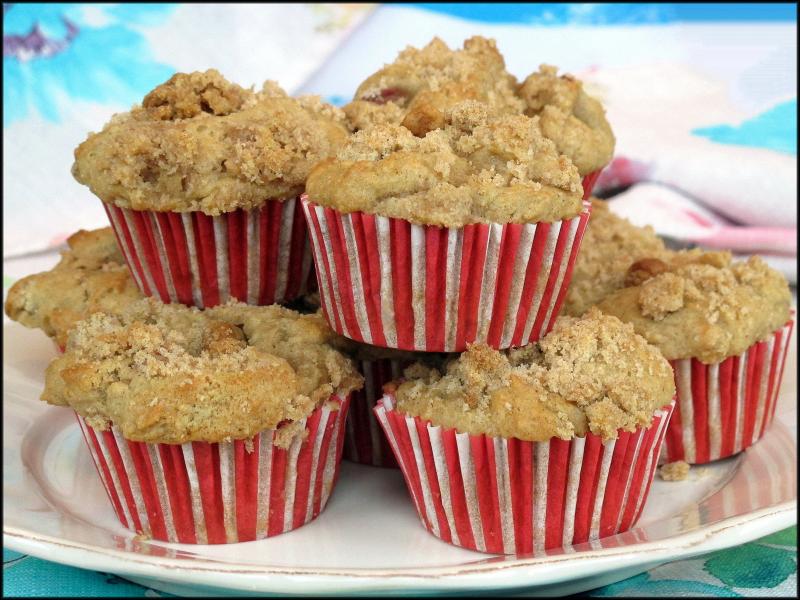Rhubarb is ideal in quick breads, adds great texture
This week’s focus is on rhubarb, an ornamental plant that is considered a fruit from both a culinary and legal standpoint. Like some flowers, it grows from underground rhizomes with celery-like stalks that can be light green to pink to a deeper red. The edible stems are topped with large, crinkled, heart-shaped, poisonous leaves. If you grow rhubarb in your home garden, it emerges in early spring, often one of the first plants to make an appearance.
Rhubarb thrives in the colder climates of the northeastern United States, the Yorkshire region of England and parts of Russia. Rhubarb originated in Siberia, and its Latin name comes from the Romans who observed it growing along the banks of the river Rha (now the Volga). Since that area was considered foreign or barbarian territory at the time, its name rha barbarum translates as “from the barbaric Rha."
Although some of the indelible, wild varieties were used in traditional Chinese medicine for thousands of years, the succulent garden variety was only considered a desirable food during the past few hundred. Marco Polo is credited with bringing the useful medicinal plant to Europe in the 13th century. By the 1600s, England was cultivating rhubarb, the price of which was three times the price of opium.
At the start of the 19th century, the English experimented with ways to cook rhubarb, in attempts to deliver its medicinal properties more readily. These experiments included different cultivation techniques, including forcing it to grow indoors in specifically designed sheds. As a result, the crop became available year-round.
Rhubarb was most often cooked into a pie filling or made into jam. Its sharp flavor is only mellowed by lots of sugar or the addition of another (sweeter) fruit such as strawberry or raspberry. Unfortunately, with the onset of the second World War, sugar shortages made it challenging for the English to cook the very tart fruit into anything remotely palatable, and rhubarb developed a less-than-delicious reputation.
Always a familiar sight in cottage gardens, as well as commercial farms in Yorkshire, rhubarb has made a comeback in recent years. A heritage crop of the Wakefield and Leeds region, this designer rhubarb (called “Traditionally Grown Yorkshire Indoor Rhubarb”) is now the focus of an annual festival, and the growing sheds have become a tourist attraction.
In the United States, rhubarb is seen at farmers markets and sold as trimmed stalks in the supermarket. Many recipes call for the addition of a great deal of sugar to tame the bitter tartness for pies and jams. The recipe below for a chutney leaves some of the tart essence intact, making the spread an excellent companion to a creamy goat cheese. The rhubarb soup, tamed by strawberries, can be served warm or chilled.
The rhubarb muffins in the photo are a good example of how ideal the fruit is in quick breads, adding great texture and flavor without making things soggy. The streusel crumble adds a sweet note, but you can make these without the topping. However you decide to add rhubarb to your menu, remember not to eat the leaves; their high concentration of oxalic acid makes them toxic. Instead, enjoy the sweet-tart flavor of spring.
Rhubarb Chutney
2 C diced rhubarb
1 Granny Smith apple
1/2 C light brown sugar
1/4 C apple cider vinegar
1/2 C raisins
1 T lemon juice
1 t ground ginger
1/2 t cumin
Place the rhubarb in a heavy, non-reactive saucepan. Peel, core and dice the apple; add to the pan. Stir in remaining ingredients and bring to a boil over medium heat. Reduce heat and simmer for 10 minutes, taking care not to let the fruit become mushy. Chill before serving. Offer alongside creamy goat cheese and crispy crackers or as a spicy sauce for roast pork. Yield: 2 1/2 C.
Rhubarb Soup
6 C 1-inch pieces of rhubarb
2 C hulled, sliced strawberries
6 C water
2 T cornstarch
1/4 C dry white wine
1/4 C sugar
1 C cream
sliced strawberries for garnish
Combine rhubarb, strawberries and water in a soup pot. Heat over medium to a simmer; continue cooking, partially covered, for 20 minutes. Strain mixture, reserving the liquid and the fruit separately. Return liquid to the pot and heat to a simmer. In a glass measuring cup, whisk together cornstarch and wine until smooth. Add 1/2 C hot soup liquid to the cup and whisk until blended completely. Add mixture to the soup pot, reduce heat to low and stir until smooth. Add sugar and reserved fruit, stirring gently. Gradually pour in cream, stirring gently. Chill before serving, garnished with sliced strawberries. Yield: 6 to 8 servings.
Rhubarb Muffins
2 1/2 C flour
1 t baking soda
1 t baking powder
1 t cinnamon
1 1/2 C diced rhubarb
1 1/4 C light brown sugar
1/2 C melted butter
1 egg
1 t vanilla
1 C buttermilk
Streusel (optional)
1 T melted butter
1/4 C flour
1/4 C light brown sugar
1/4 t cinnamon
Preheat oven to 350 F. Line a 12-cup muffin tin with paper liners or coat with nonstick cooking spray; set aside. In a large mixing bowl, stir together dry ingredients. Add the rhubarb and toss to coat; set aside. In a mixing bowl, combine the brown sugar, melted butter, vanilla and buttermilk; whisk until smooth. Make a well in the center of the dry ingredients; pour in the liquid and stir just until combined. Do not overmix. Distribute the batter into the prepared pan. If adding the streusel topping, combine the streusel ingredients in a small bowl and drop 1 teaspoonful on each muffin. Bake just until cooked through, about 20 minutes. Allow to cool slightly before serving. Yield: 12 muffins.






















































